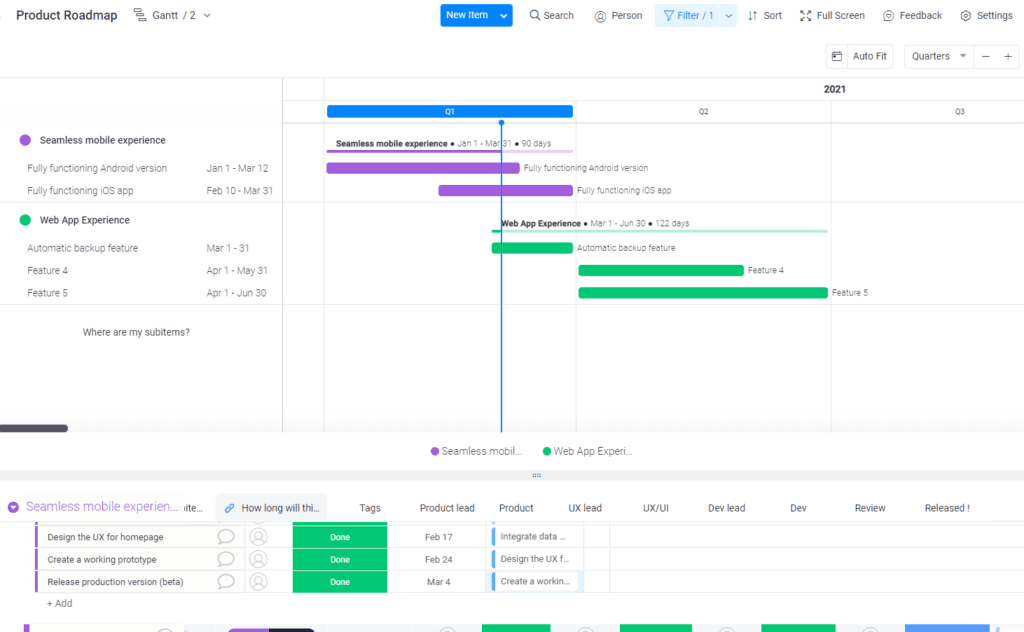In this article, you’ll learn how to best create your own project roadmap, by covering what it is, when to use it, and how you can create one with monday.com’s project roadmap tools.
What is covered in this blog post:
- What is a project roadmap?
- What should a project roadmap include?
- What is the difference between a roadmap and a plan?
- When should you use a project roadmap?
- How to create a successful project roadmap?
- Challenges of a project roadmap

Project management provides leadership and vision, motivation, removing roadblocks, coaching, and inspiring the team to do their best work. Project managers serve the team, but also ensure clear lines of accountability. With a project manager in place, there’s no confusion about who’s in charge and in control of whatever’s going on in a project (especially if you’re using a RACI chart or other similar tools). Project managers enforce processes and keep everyone on the team in line too because ultimately they carry responsibility for whether the project fails or succeeds.
What is a project roadmap?
Roadmaps are a visual representation of project objectives and expected results. They help manage stakeholder expectations, communicate project details to stakeholders, and even identify risks early on.
As the name suggests, a project roadmap is a rough sketch of the route your project must take in order to reach its goals. The roadmap is typically composed of a series of tasks, each with clear milestones, start and end dates, deliverables, budget estimates, and other key details. Like any roadmap for real-world travel, the visibility it provides can be particularly useful for navigating through a complicated project that has few distinguishing characteristics or unique challenges.
What should a project roadmap include?
A project roadmap is a visual representation of the big picture that helps teams and managers alike to: clarify expectations, organize project elements, make better decisions, highlight risks, and focus on deadlines.
A project roadmap covers all the major milestones for your project—including objectives, deliverables, and timeline. This can be an extremely helpful way to stay on task during a busy work day.
What is the difference between a roadmap and a plan?
Any project plan should include a roadmap, which is a high-level overview of what you want to achieve. A roadmap can be as simple as one page, or up to 10 pages for a large project. It’s important to keep the roadmap concise and relevant, with just enough information, so it can be shared with others. Your roadmap should include the following:
- What will you deliver?
- When will you deliver it?
- How will you measure success?
- Who will own each milestone?
- What resources will you need?
A project plan is an essential tool for managing workflow, scope, and budget during a project. However, it’s often difficult to know how much detail to include in the plan, and what needs to be identified upfront versus when the project begins. monday.com Project Roadmap template will allow you to outline your project from beginning to end with just enough detail for you to be sure that you are on track.
When should you use a project roadmap?
You may want to quickly communicate important project information when working with many team members, without getting bogged down in the details. The project plan template is ideal for this situation.
Roadmaps help teams plan and track projects. They also assist in communication and collaboration between team members. A roadmap provides a high-level overview of the tasks planned, their dependencies, and the timeline for completion. It reduces communication overhead as well as timelines by making it easier for team members to understand what’s going on in a project at any given time without having to wait for progress updates.
A project roadmap is an overview of the major milestones for a project, but it’s not the best way to keep the people ‘in the weeds’ up to date. Once the project is underway, team members should know what’s on the roadmap, but their main focus is completing their daily tasks (not looking at it). You need a Daily Task tracker where they can put in what they did and what they plan to do tomorrow—a place where they can collaborate with others easily and update you when something comes up.
How to create a successful project roadmap?

Write a business case
In order to accomplish a project, you need a roadmap. This is a high-level overview of what you plan to achieve over the coming months and years. Start by describing the project and justifying why you’re doing it. Outline its benefits, costs, and risks before moving on to the next steps like drafting a detailed plan or creating prototypes.
Write a project charter
To create a visual roadmap, you should start with a blank slate. Your roadmap will help you visualize your goals and objectives, and it will help you stay focused on the big picture. If you’re looking to grow your company, you may want to consider creating multiple roadmaps, each representing a specific phase of growth.
Start with a template
A project roadmap is a tool for communication, planning, and aligning stakeholders. With it, you can build your roadmap from a template, it will make you save a lot of time and will ensure your project roadmaps always look the same.
Input your essential project information
It is now time to populate your project roadmap with all the data we talked about above :
- The goals/objectives for your project (along with potential risks)
- The benefits or potential ROI of reaching these objectives/goals
- A high-level timeline showing the entire scope of the project with prospective delivery dates
- Workstreams for each of the teams working on the project (marketing, IT, sales, etc.)
- High-level activities to be achieved (think overall weekly/monthly tasks, not daily/hourly)
- Defined project milestones (getting funding, finding a vendor/contract, completing the code, etc.)
Collaborate with stakeholders
It’s important to get some feedback and guidance from key stakeholders before you start building out your roadmap. They can help fill in the blanks and ensure that you’re on the right path. Getting their buy-ins beforehand will save you time and effort later on!
A project management roadmap helps avoid miscommunication between stakeholders and your team by ensuring everyone stays on the same track. It can also clarify to stakeholders the steps that were taken during the execution of the project.
To keep everyone in the loop, monday.com enables you to quickly create shareable roadmaps and project plans that can be accessed by anyone at any time via the web or mobile app.
Communicate With Other Teams
As appropriate, you should be able to share your project roadmap with anyone related to the project. Any recipient of the roadmap should know that the information they are receiving is timely and accurate, so you should label it as current as possible.
Stimulate Priority Decisions
In today’s fast-paced environment, it can be challenging to stay on top of all of your tasks. As new constraints and variables arise, refer to your project roadmap for the most important goals and deliverables, which will help you to prioritize tasks and make decisions quickly.
Update, all the time
In an agile project, there’s a lot at stake if a team misses a deadline, or if it moves too slowly. Your roadmap should reflect changes in timelines, resources, milestones, and dependencies. You can make adjustments for your team frequently to ensure that you end up with the best possible outcome.
It’s essential to make sure that the roadmap is kept current, and that all relevant teams and individuals have access to the current version at all times.
Challenges of a project roadmap
When it comes to project management, a project roadmap can help you achieve your goals. A well-constructed roadmap can help you keep a high level of communication across the team, increase visibility and keep everyone on track. The very nature of project management means that, despite its many benefits, a project roadmap comes with its own set of challenges.
- Your roadmap should only provide an overview of the project and avoid details that can be difficult to understand at a glance. Ensure that your project is presented in a professional format and that the inclusion of all relevant information can be easily identified, by using clear colors, headings, and relevant images.
- Teams often focus heavily on the research and execution of the project in the roadmap and neglect testing and feedback from real users. Getting real user feedback will inform the next iteration, but even more importantly, it informs how to incorporate feedback into the vision for subsequent iterations.
- A project roadmap is more likely to be successful when your entire team and stakeholders agree with it. This way, everyone from the project manager to executives will understand what needs to be done and when.
Your project roadmap is the central document of your project and should answer key questions for stakeholders and the project team. It can be thought of as a tool to help everyone understand the project’s overall goals, objectives, scope, and other high-level details.
Final Thoughts
If you have never taken your business to the next level, used a roadmap before, or aren’t quite sure what it is, then this course is for you. Roadmapping helps you gain clarity and keep your goals in focus.
Roadmaps are a crucial aspect of any project, and you need to make sure they’re flexible, visual, and easy to share. monday.com is the best way to guarantee this. Start now your roadmap by creating a free project roadmap template with monday.com
Recommended Reads:



